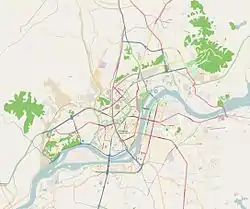Pyongyang Department Store No. 1
The Pyongyang Department Store No. 1 is a major retail store in Pyongyang, North Korea. On Sungri Street near Kim Il-sung Square in downtown Pyongyang,[2] it is one of the largest retail stores in the country and is often the site of large commodity exhibitions.[3]
| Pyongyang Department Store No. 1 | |
|---|---|
.jpg.webp) Pyongyang Department Store No. 1 | |
 Location in Pyongyang | |
| General information | |
| Address | Sungri Street |
| Coordinates | 39°1′20.14″N 125°45′11.42″E |
| Design and construction | |
| Architect | Yun Ko-gwang[1] |
| Other information | |
| Public transit access | |

The store, along with two others, are run reportedly jointly with Chinese business partners.[4]
Shopping
The store offers a variety of items including electronics, clothing, furniture, foodstuffs,[5] kitchenware, and toys.[2] As of 2013, approximately 70 percent of the items in the store were produced domestically.[6] The store is also one of several official tourist stops in the city.[7] Department Store No. 1 accepts only local currency.[8] It is a popular shopping destination for local residents and in 2016 an average of 20,000 shoppers visited the store daily. [9]
Swedish journalist Caroline Salzinger described her visit to the department store as a tourist in the mid 2000s. Upon arrival, the store was closed.[10] One of the tour guides accompanying her tried to distract her, while the other one rushed in to get the doors opened. When opened, the guide had to scramble passers-by to occupy the store as "shoppers". The moment they stepped in, the escalator was started.[11] The shoppers appeared clueless as how to act in a department store. When after great pains Salzinger managed to purchase the goods she wanted,[12] the cashier was confused and would not hand her a plastic bag for her items: "We look at each other in the eyes. She knows that something is wrong, and that not everything is like it should, but she does not know what it is."[13]
According to Salzinger, a Western diplomat monitored the department store for one hour and saw no one come out with purchased items.[12]
Theodore Dalrymple visited in 1989. He described the Potemkin nature of the place: "I also followed a few people around at random, as discreetly as I could. Some were occupied in ceaselessly going up and down the escalators; others wandered from counter to counter, spending a few minutes at each before moving on. They did not inspect the merchandise; they moved as listlessly as illiterates might, condemned to spend the day among the shelves of a library. I did not know whether to laugh or explode with anger or weep. But I knew I was seeing one of the most extraordinary sights of the twentieth century."[14]
See also
References
- Choe Kwang (April 2014). "50-Year Devotion to Education". Democratic People's Republic of Korea. No. 700. p. 29. ISSN 1727-9208.
- Hokkanen, Jouni (2013). "Pohjois-Korea: Matkailijan opas" [North Korea: Traveler's Guide]. Pohjois-Korea: Siperiasta itään [North Korea: East of Siberia] (in Finnish). Helsinki: Johnny Kniga. p. [10]. ISBN 978-951-0-39946-0.
- "Commodity Exhibition Held at Pyongyang Department Store No. 1". Korean Central News Agency. December 6, 2012. Archived from the original on October 12, 2014. Retrieved July 6, 2013.
- Jae Cheol Kim (Nov 1, 2006). "The Political Economy of Chinese Investment in North Korea". North Korean Economy Watch. Retrieved July 6, 2013.
- Pak Won Il (Feb 25, 2012). "North Koreans Experience The Marvels Of A Supermarket Firsthand". Business Insider. Archived from the original on April 10, 2013. Retrieved July 6, 2013.
- Curtis Melvin (Feb 22, 2013). "North Korean products in department stores on the rise". North Korean Economy Watch. Retrieved July 6, 2013.
- "Kumgangsan Tour". Koryo Tour Group. Archived from the original on April 11, 2013. Retrieved July 6, 2013.
- e.g. Andrei Lankov, Money matters: the three-tiered system of the 1980s North Korean currency, NKNews 28 May 2014;http://www.nknews.org/2014/05/money-matters-the-three-tiered-system-of-1980s-north-korean-currency/ and Rob York, Black market cash, The real value of N. Korean Won, in: NKNews, 1 September 2014; http://www.nknews.org/2014/09/black-market-cash-the-real-value-of-n-korean-won/
- https://www.upi.com/Top_News/World-News/2016/11/02/Report-North-Korea-department-store-gets-20000-visits-a-day-offers-delivery/9321478112084/
- Salzinger 2008, p. 47.
- Salzinger 2008, p. 48.
- Salzinger 2008, p. 49.
- Salzinger 2008, p. 50.
- A. M. Daniels (1991). "North Korea". The wilder shores of Marx: journeys in a vanishing world. Hutchinson. p. 54. ISBN 009174153X. Retrieved 27 April 2020.
I also followed a few people around at random, as discreetly as I could. Some were occupied in ceaselessly going up and down the escalators; others wandered from counter to counter, spending a few minutes at each before moving on. They did not inspect the merchandise; they moved as listlessly as illiterates might, condemned to spend the day among the shelves of a library. I did not know whether to laugh or explode with anger or weep. But I knew I was seeing one of the most extraordinary sights of the twentieth century.
Works cited
- Salzinger, Caroline (2008). Terveisiä pahan akselilta: Arkea ja politiikkaa maailman suljetuimmissa valtioissa (in Finnish). Translated by Lempinen, Ulla. Jyväskylä: Atena. ISBN 978-951-796-521-7.CS1 maint: ref=harv (link)